
|
|
North AmericaNative American Star LoreQ - Z |
|



|
|
Sagittarius
Shash, the Bear constellation is considered a spring and summer constellation. It consists of the stars of the Greek constellation
Sagittarius.
|

|



|
|
Scorpius |

|
|
Cherokee
To the Cherokee, Sirius (α CMa) and
Antares (α Sco) are the dog stars that guard the end of the "Path of Souls", the
Milky Way. Sirius
in the winter sky guards the eastern end, while Antares in the summer sky guards the eastern end.
|

|


|
|
Navajo
The constellation Átsé Etsoh, First Big One, depicts an elderly man with a cane and a basket of seeds. He rep-resents the wisdom of the elders
and the concept of Sá'áh Naagháii Bik'éh Hózhóón, the concept that "with old age comes happiness or contentment." His a cane provides
strength and stability.
|

|


The "Tail" of the Scorpion, consisting of λ, κ,
υ and ι1Scorpii
is called Gah Haat'e'ii, the "Rabbit Tracks."
 Navajo hunters used these stars to determine when the traditional hunting season would begin. As long as the "Rabit Tracks" remained up right in one position, young deer still depended on their mothers for nourishment and thus, deer were not hunted. on their mothers for nourishment. Only when ste stars tips to the east, it was deer hunting season.  Sources: Navajo Skies, grandcanyon.org, Navajo Astronomy |
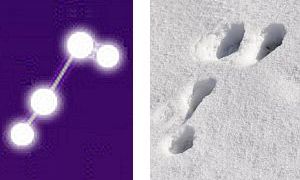 Gah Haat'e'ii - Rabbit Tracks
Gah Haat'e'ii - Rabbit Tracks
|

Also part of Scorpius is Kaalogi, the Butterfly constellation. It is adjacent to the First Big One, Átse’ Etsoh.
 It is considered a summer constellation, visible during the time when butterflies are migrating through the Navajo Nation.  Navajos, like other southwestern tribes, respect the butterfly as a symbol of the process of change, growth and regeneration.  Source: Navajo Skies |
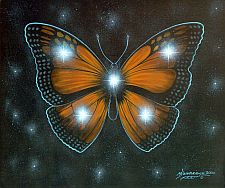 Kaalogi
© Melvin Bainbridge
Kaalogi
© Melvin Bainbridge
|


|
|
Ojibwe
On the Ojibwe Star Map, the constellation
Scorpius is depicted as Nanaboujou, the Sleeping Giant. He is a hero figure and a spirit that had many
excursions on Earth a long time ago. He helped the people by creating dry land after the last flood. The constellation shows Nanaboujou
shooting an arrow at the Great Panther, represented by the constellations Leo and
Cancer.
|

|


|
|
Pawnee
The Skidi Pawnee called Antares the "Red Star" (see "Four Directions" above).
|



|
|
Scorpius and Serpens |

|
|
Cree
The first rising of Serpens in early summer signaled the arrival of the thunderstorm season.
The Cree people in what is now Canada saw Nipin Pinisew, a Thunderbird in the northern stars of Scorpius and
the stars of Serpens.
|

 Thunderbird; © Native Skywatchers
Thunderbird; © Native Skywatchers |
 Thunderbird in a Cree petroglyph
Thunderbird in a Cree petroglyphSource: Atchakosuk |
 Thunderbird Constellation
Thunderbird ConstellationSource: Atchakosuk |



|
|
Taurus |

|
|
Inuit
The Inuit in northern Canada, call the constellation
Taurus, Nanook, the "spirit
of the Polar Bear."
Another Wikipedia source uses the word Nanurjuk.
|
 Nanook, the Great Polar Bear Spirit
Nanook, the Great Polar Bear SpiritSource: Gods & Goddess Wiki |


|
|
Navajo
The constellation Sò‘ Ahóts’i’, Pinching or Doubtful Stars is located in the Hyades star cluster.
It is associated with Dilyéhé and Átsé Ets’ózí. The name Sò‘ Ahóts’i’ refers to doubtful or pinching stars. Pinching may allude to the
closeness of the twin stars, while doubtful may refer to their parentage.
|
|
The Hyades star cluster also includes two stars that depict the Hero Twins, who slay the
monsters and make earth safe for humans. There are many stories of their exploits, which are well known to most Navajos.
|
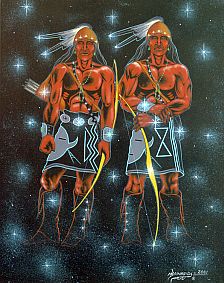 Naayéé’ Neizghání & Tóbájíshchíní
Naayéé’ Neizghání & Tóbájíshchíní© Melvin Bainbridge |


|
|
Ojibwe
On the Ojibwe Star Map, Aldebaran (α Tau),
together with Procyon (α CMi) and the stars of Orion,
are called Biboonkeonini, the Winter Maker, as their presence in the
night sky heralds winter.
|

|


|
|
Dakota
Serpent Mount in what is now Ohio
is a large Effigy mound. Those mounds are remnants of early Native American cultures, raised
piles of earth built in the shape of a stylized animal, symbol, human, or other figure and generally containing one or more human burials. Carbon dating
suggests, that Serpent Mound was erected by the Fort Ancient people around 1070 AD.
|

|
 Please note that the connection between the Serpent Mount and Dakota star lore is a mere speculation by the author. |



|
| Triangulum and Aries |

|
|
Dakota and Lakota
The Dakota and Lakota combined Hamal and
Sheratan (α and β Arietis) with the stars of Triangulum
to Chanśáśa ipúsye, which translates litelally to "Dried Willow" or "Red Willow."
|
 Lighting a pipe
Lighting a pipeSource: One Spirit |



|
|
Ursa Major |

| In order to keep similar stories together, the sources of the legends of Ursa Major are not sorted alphabetically, but rather (roughly) geographically, from north to south. |


The most popular version of the hunting story in North America is based on the position of the Great Bear in the sky after sunset during the seasons
of the year:
|
In spring, shortly after dark, the bear, represented by the four stars of the dipper, seems to be climbing out of her den, which is symbolized by
Corona Borealis, the circle of stars that appear higher up.
 In midsummer, she runs she runs along the northern horizon, pursued by seven hunters - the tree stars of the dipper’s handle and four additional, nearby stars.  By mid-autumn, the bear stands erect, ready to defend herself. At this time of year, however, in northern latitudes, only the three hunters on the dipper’s handle always stay above the horizon, they are the ones referred to as “the hunters that are always hunting.” the other hunters of the story circle below the horizon and loose the trail.  Later in the season, the bear appears to be falling on her back and is killed by the hunters. Her blood stains the autumn trees bright red.  In midwinter, as she is lying on her back, her den appears in the east to carry the sleeping new year’s bear within.  Source: Stewart, Williamson; They dance in the sky: Native American star myths p. 18 |
 The position of the Big Dipper
The position of the Big Dipperafter sunset throughout the seasons |


|
|
Inuit
Astro-Canada tells a brief Inuit version of the
Big Hunt:
Aside from the hunting story, in Inuit folklore, Ursa Major is know as Tukturjuit, the
Caribou. To some Inuit, the star group is one single caribou; to others it
is a flock of seven, one for each star.
|

|


|
|
Miꞌkmaq and Iroquois
The Miꞌkmaq People of Nova Scotia and the
Iroquois People along the St. Lawrence seaway were among the first to inherit the story about
the Big Bear from their Siberian ancestors. In their version, the quadrangle of the dipper
(Dubhe, Mera,
Phad and Megrez)
represents a bear that is pursued by seven brave bird hunters.
|
 The Great Bear Hunt; star-name-registry.com
The Great Bear Hunt; star-name-registry.com
|
(Frank Dempsey
identified Horned Owl as Arcturus (α Boötis) and the other three as "several of the
stars between Arcturus and the handle of the Big Dipper").
 As the bear attempted to stand up on two legs, Robin wounded her with an arrow and the bear's blood colored the leaves of the forest red. The wounded bear also sprayed on Robin. which was henceforth called Robin Redbreast. |

Eventually, the bear died and was eaten. The skeleton remains traveling through
the sky on its back during winter. During the following spring a new bear leaves the den and the eternal hunt resumes once more.
 Sources: American Association of Variable Star Observers, University of Arizona
Frank Dempsey tells
another Iroquois legend, in which three hunters and their dog were
hunting Nya-gwa-ih, the Celestial Bear. They " ...came tantalizingly close to killing the bear, but the bear always outran them. They wowed to
never stop until they overtook and killed the bear. The bear led then far north and into the sky, where they can be seen as the three handle stars
with the dog near the middle star and the bear as the bowl stars of the dipper."
|
 Nya-gwa-ih at Pinterest
Nya-gwa-ih at Pinterest
|


It just so happened that the seven best trackers and hunters were birds and off they flew. The hunt was on as Tehpakoop Pinesisuk, the
Seven Birds (Represented by the constellation Corona Borealis), chased Mista Muskwa.
 Not all beings were put off by the activities of the bear. The ravens found that they could have a comfortable, well-fed life if they just followed the bear around and feed on its left-overs. When they heard about what was to hap-pen to the bear, the ravens went straight to Mista Muskwa and told him. He was outraged and set immediately out to find these 'great hunters'. So it was that around the 11th and 12th full moons of the year, a confrontation between Mista Muskwa and the hunters occurred. |
This confrontation was brief and did not lead to violence because when
Mista Muskwa failed to scare his pursuers, he turned and fled, as all bullies do when confronted with determination and resolve.
 It is said that Mista Muskwa and his pursuers were so fast that they flew into the northern night sky. Just as this happened, the bear was mortally wounded and he turned and faced his attackers. Mista Muskwa was bleeding badly and he shook, as a wet dog would shake, and as he did, blood from his wound fell to the earth and landed and stayed on all the broad leafed plants. That is why the leaves of all broad-leafed plants change color in the fall.  As Mista Muskwa shook, he also splattered a drop of blood on the bird that mortally wounded him. To this day, pipichew – the robin – has a red chest.  To remind all of the rewards of bullies, Mista Muskwa was placed in the sky along with the seven birds. Pipichew (the brightest of the seven birds) was given a further honor by being granted a special egg. It was the color of the sky and had speckles that represented the stars."  Source: Wilfred Buck: Ininewuk Stories of the Stars |
 The great bear hunt; Source: indiantime.net
The great bear hunt; Source: indiantime.net
|


|
|
Coeur d'Alene
The Coeur d'Alene people in what is now Washington State see a grizzly bear in the cup of the "Big Dipper" and have a story about how it got into
the skies:
|
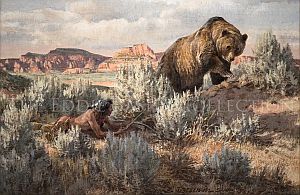 Grizzly bear hunt; © Tom Beecham
Grizzly bear hunt; © Tom Beecham
|
The four stars which form the cup of the Great
Dipper are Grizzly’s feet. The northern one moved and made the track formed by it and the star immediately above it. The three stars of the
handle are the brothers-in-law, the one nearest the cup is the one who liked Grizzly best.
 Sources: Gladis A. Reichard: An Analysis of Coeur d'Alene Indian Myths Stewart, Williamson: They dance in the sky |


|
|
Meskwaki
The Meskwaki people in present day Michigan tell another variant of the hunting myth.
|


|
|
Wasco
The Wasco people in what is now Oregon tell a hunting story from the time before humans:
|

|
The next morning coyote, the five wolf brothers, and their dog climbed the arrow trail. They climbed for many days and nights, and finally reached
the sky. The two animals in the sky were fierce grizzly bears, and coyote was afraid. But the two youngest wolf brothers were not afraid. They
approached the grizzly bears and nothing happened, so the next two wolf brothers followed. Finally, the oldest wolf brother and his dog
joined the group.
 Coyote admired the beautiful picture they made in the sky. He began to back down the trail of arrows, breaking off the arrows as he went. To this day, the wolf brothers and their dog face the two grizzly bears in the sky. We call this sky picture the Big Dipper. When Meadowlark sings at night, he is telling everyone to come and look at coyote's picture in the sky.  The grizzly bears are the stars in the Big Dipper's bowl that point to the North star. The youngest wolf brothers are the stars that face the bears across the bowl of the dipper. The middle wolf brothers are the fist and last stars in the handle of the dipper. The oldest wolf brother and his dog are Mizar and Alcor, the two stars which appear as the middle star of the handle.  Sources: University of Arizona, Stewart, Williamson: They dance in the sky  Extended versions of this story can be found at whitewolfpack.com and firstpeople.us |


|
|
The Chinook, neigbors of the Wasco tell a
similar story that can be found here.
 Source: tell-me-a-story |


|
|
Snohomish
Not every hunting story targets a bear. The Snohomish people in what is now Washington State
tell a story about an elk hunt. This version of the Cosmic Hunt also has its roots
in Siberia:
|

|
Having nowhere
else to go the four elk jumped up into the sky and kept on running. The hunters wasted no time in following the elk and they too jumped up into the
sky. It was then that the people pushed up the sky leaving the elk and hunters with no way to get back down to earth.
 You can still see the hunt going on today. The four stars of the Big Dipper's bowl are the four elk. The three stars in the Dipper's handle are the hunters. The little star next to the middle hunter is his dog.  Sources: Modern Constellations, Stewart, Williamson: They dance in the sky |


|
|
Ojibwe
The Ojibwe envisioned the Big Dipper as a
fisher (Pekania pennanti), a mamal belonging to the weasel family.
|

|
 The spirits took pity on him, and caught him before he hit the ground, and gave him a place of honor in the sky. That place is the visible constellation we were raised to call the big dipper, and the handle is the tail. Every year, he makes his journey up into the sky, and every winter he breaks through to free the songbirds and the warm weather. And, every winter he is struck by the arrow and begins to fall back first from the sky. But then, as he brings an end to winter, he returns to earth and the journey begins anew."  Sources: WPXR.org, Stewart, Williamson: They dance in the sky |


|
|
Blackfoot
In a variation of the prehistoric tale of the Seven Brothers, the
Blackfoot people tell a legend of seven brothers and their little sister.
The tale is popular among all nations of the Plains Indians and some of the nations of the Northeastern Woodlands. |

|


|
|
The Assiniboine had a similar story; only in their version, there were only six brothers and a little sister. |

|
|
In the Penebscot people’s version of the tale, there were six brothers and an older
sister, which turned into a bear that killed everyone in the village except for the two youngest children. When the six brothers returned, they
were all able to escape into the sky.
 Source of all the above: Frank Dempsey
|


|
|
Cheyenne
In North America, the most popular version of the tale of the seven brothers is told by the
Cheyenne, who moved from a region west of the Great Lakes westward to the Great Plains.
|

|


|
|
Dakota Together with the Lakota the Dakota form the two main groups of the Sioux people. They have several meaning for the asterism known as the Big Dipper:
To Win/Tuƞ Wiƞ - Blue Woman/Birth Woman
Wiçakiyuhapi - Stretcher
Oceti Sakowiƞ - Seven sacred rites/council fires
Çaƞnunpa - The Sacret Pipe
|

|


|
|
Pawnee
The Skidi Pawnee saw the stars of the Big Dipper and the
Little Dipper as stretcher-bearers who carried the sick and
the death.
|

|
Ursa Minor, the "Little Dipper" was seen as Small Stretcher Bearing a
Sick Child.
 Polaris, the Star That Does Not Walk Around was seen as a chief watching over the the Stretcher-Bearers as they traversed through the sky.  Both constellations are close to the Milky Way, which was seen as the path the spirits of the dead take as they are blown along from north to south by the north wind.  Sources: Stewart, Williamson; They dance in the sky: Native American star myths, p. 52, native-science.net, Ralph N. Buckstaff: Stars and constellations of a Pawnee sky map, George E. Langford: Reachable Stars, |


|
|
Navajo
The stars of the Big Dipper, called Náhookòs Bi’kà’, the Male Revolving One,
can be culturally seen as a male warrior, a leader who protects his people. He is sympathetic and charismatic, as well as a provider for his family
and home.
|
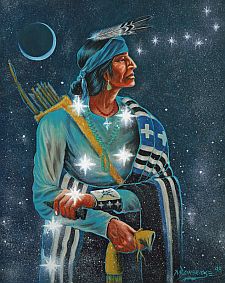 Náhookòs Bi’kà’
© Melvin Bainbridge
Náhookòs Bi’kà’
© Melvin Bainbridge
|



|
|
Ursa Minor |

|
|
Cree
The Cree call the seven stars that make up the Little Dipper Atima Atchakosuk, the Dog Stars.
|
 Atima Atchakosuk; Source: Atchakosuk
Atima Atchakosuk; Source: Atchakosuk
|
Our natootim-uk, our relatives, the Wolf, Coyote and Fox saw this and were concerned.
 The wolves held a council and it was decided that they would send two of their own to live with the people. The council of Coyotes and council of Foxes also decided this same action.  Two pups from each of the councils were sent to all the four directions of humankind. They came, adapted, changed and flourished. From these gifts came all the dogs that now inhabit the world. These dogs now guard our homes, communities, camps, and loved ones.  To honor this sacrifice made by our natootim-uk, the Creator placed a reminder of the dogs in the heavens, which would forever be a guardian for humans. Polaris anchors the dogs’ leash as the dog runs around the circumference of the sky-camp, alert and ever on guard.  The stars of this constellation, particularly those on the handle of the Little Dipper, represent the Wolf (Polaris), the Coyote (δ UMi) and the Fox (ε UMi); the four bowl stars represent the pups that were sent to the four directions of humankind.
Polaris is also known as Keewatin, the Going Home Star. It represents the northern direction
and keewatinook – the north winds. It is an important star for people who live under the Ahkoop Atchakosuk, or blanket of stars.
|

With their Ojibwe and Dakota neigbors,
the Cree share the legend "How Fisher went to Skyland"
(see here).
 Some anthropologists believe the legend dates back to a time of perpetual winter - the end of the last ice age, when the first people migrated to North America.  Ocik Atchakosuk, the fisher (Pekania pennanti) is a mamal belonging to the weasel family. While the Ojibwe placed Fisher in the sky as the Big Dipper, Cree astronomy visualized it as Ursa Minor.  Source: Atchakosuk |
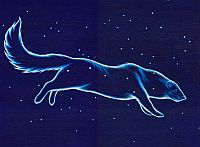 Ocik Atchakosuk
Ocik AtchakosukSource: Atchakosuk |


|
|
Inuit
In Inuit astronomy, the three brightest stars - Polaris,
Kochab and
Pherkad - were known as Nuutuittut "never moving", though the term is more
frequently used in the singular to refer to Polaris alone.
|


|
|
Navajo
The North Star, called Náhookòs Bikò‘, the Central Fire, depicts the central fire of a
hogan, a Navajo home.
|
 Náhookòs Bikò‘
© Melvin Bainbridge
Náhookòs Bikò‘
© Melvin Bainbridge
|


|
|
Ojibwe
On the Ojibwe Star Map, Ursa Minor is depicted as Maang, the Loon.
|

|


|
|
Pawnee
The Skidi Pawnee saw the stars of the Big Dipper and the
Little Dipper as stretcher-bearers who carried the sick and
the death.
|

|



|
|
Winter Hexagon |

|
|
Lakota
Gleœka Wakaŋ, the Sacred Hoop is a ring of red clay surrounding Paha Sapa - the Black Hills. It is also called Ki Iŋyaŋka Oçaŋku,
the Racetrack.
|

|
Dakota astronomy puts the race track into the heavens, connecting some of the brightest stars of the winter sky. The constellation is almost
identical with the "western" asterism Winter Hexagon. The only difference: It bypasses
Aldebaran (α Tau) and extends into the Pleiades.
 Clockwise, the racetrack connects Sirius (α CMa), Procyon (α CMi), Pollux (β Gem), Castor (α Gem), Capella (α Aur), the Pleiades and Rigel (β Ori).  Sources: Dakota Constellation Guide, Akta Lakota Museum, lakotajewelry.com, Astro by Mark |


 |
Back to Part 2 | Forward to Native American Start Page |
 |


|
Back to Star Lore |
Back to Mythology |
 Back to North American Star Lore |
Back to Space Page |
Back to English |
 Back to Start Page |